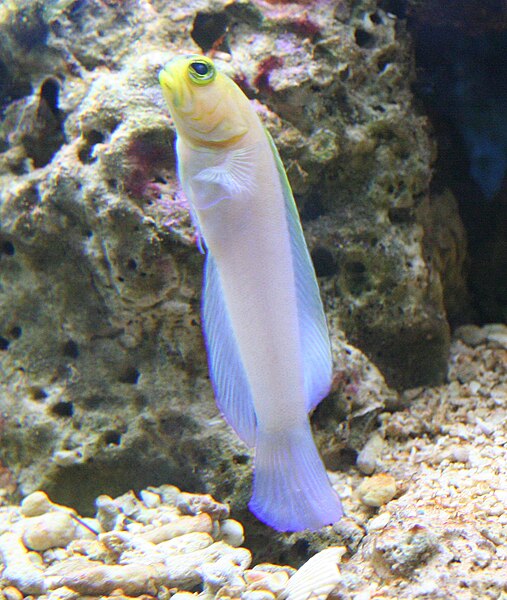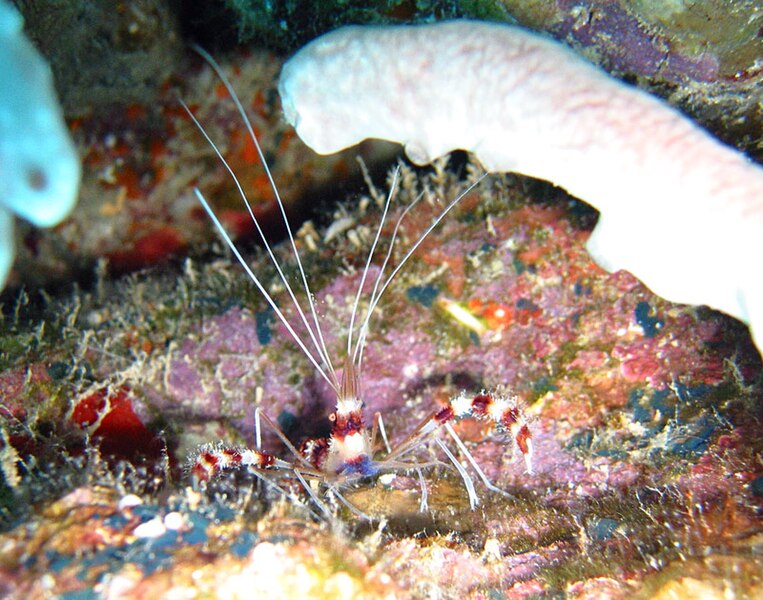
Hello, Frank Indiviglio here. Seahorse husbandry has advanced quite a bit in recent years, with several species having now been bred in captivity. One stumbling block, however, is the near impossibility of keeping Seahorses with other marine creatures. Seahorses are slow, methodical hunters, and the live foods they require are also favored by other fishes. In typical community aquariums, food is gobbled up by other species before the Seahorses even know its feeding time. But there are some options…following are a few creatures that I’ve experimented with over the years.
Pipefishes
Pipefishes are classified with Seahorses in the order Syngnathiformes, and are also confirmed live-food specialists that hunt in a similarly slow manner. They are the best choice as Seahorse companions –all those I’ve kept have gotten along very well with Seahorses.
The Banded Pipefish, Doryrhamphus dactyliophorus, strikingly marked in red and yellow, makes a spectacular tank mate for tropical Seahorses.
The Northern Pipefish, Syngnathus fuscus, may be easily collected along much of the USA’s Eastern Seaboard. I have found it to be among the hardiest of all Pipefishes. It is best kept with Northern Seahorses, Hippocampus erectus, and other temperate-zone species.
Sticklebacks
Sticklebacks are distantly related to Seahorses. They are more alert as regards food, but have small, easily-satisfied appetites. They fare poorly with more aggressive fishes, and rarely give Seahorses any trouble.
 Males use an adhesive manufactured in the kidneys to construct enclosed nests of plant material, and may do so if given the opportunity in captivity…an event not to be missed (indeed, fresh-water Sticklebacks were the first fishes to be kept by European hobbyists).
Males use an adhesive manufactured in the kidneys to construct enclosed nests of plant material, and may do so if given the opportunity in captivity…an event not to be missed (indeed, fresh-water Sticklebacks were the first fishes to be kept by European hobbyists).
Rarely offered in the trade, the Three Spined Stickleback, Gosterosteus aculeatus, may be easily collected via seine nets.
Gobies
Gobies belong to the world’s largest fish family, with over 2,000 species described thus far and new ones – up to 25 per year – being discovered regularly.
Many dig burrows and “scurry” about in a most amusing fashion. They are alert feeders, but most refuse to stray far from their burrows, and so are easy to manage (individuals vary in this regard, however).
The Pearly Jawfish, Opistognathus aurifrons, constantly pops in and out of its home burrow and is a great favorite among aquarists. It fares well with larger Seahorses.
I’ve collected Naked Gobies, Gobiosoma bosci, in discarded tin cans lying among eelgrass, and have found them to be excellent companions for the tiny Dwarf Seahorse, Hippocampus zosterae, and other species.
Shrimps
 I always advise including shrimps in Seahorse aquariums, as many will breed and the young are an invaluable addition to Seahorse diets. Beware of large, heavily-clawed species.
I always advise including shrimps in Seahorse aquariums, as many will breed and the young are an invaluable addition to Seahorse diets. Beware of large, heavily-clawed species.
The brilliant red-and-white Banded Coral Shrimp, Stenopus hispidus, establishes long term pair bonds; males even share food with gravid females. They make excellent additions to aquariums housing Yellow Seahorses, Hippocampus kuda, and other tropical species.
Tiny Grass and Sand Shrimps, Palaemonectes and Crago spp., may be collected in most marine waters. They are always on the go, fascinating to observe, and make wonderful scavengers. Many breed readily in the aquarium.
Other Possibilities
Certain Hermit Crabs, Spider Crabs, Sea Stars, Brittle Stars, Urchins, Snails and Tube Worms may be maintained with Seahorses. I’ll cover their care in future articles…until then, please write in for information.
As you can see, Seahorses need not be confined to single-species tanks. The possibilities are endless…please write in with your own ideas.
Thanks, until next time,
Frank Indiviglio
Further Reading
Please check out my book on Seahorse Care.
Video: Pipefishes and Seahorses in a public aquarium
Pearly Jawfish image referenced from wikipedia and originally posted by Michael Wolf
 That Fish Blog – Aquarium Advice and Information
That Fish Blog – Aquarium Advice and Information

Love SeaHorses they are so unique
Hey, Frank, great article. I’ve also kept pipefish with seahorses, but a lot of keepers worry about Vibrio, and rightly so.
I consider Brotulids and Curious Wormfish to be completely seahorse safe, even with juveniles. I also keep a Blue Jaw Tilefish and a Many-lined Basslet with my adult seahorses.
Hello Felicia, Frank Indiviglio here.
Thanks for the kind words and interesting comment.
Yes, Vibrio and other disease/parasite concerns must always be kept in mind; quarantine tanks are a bit of extra work, but well-worthwhile in my opinion, especially for wild-caught specimens.
I haven’t tried Curious Wormfish or Blue-Jaw Tilefish, but sounds like a great idea; I’ve found that many gobies and “goby-like” species, especially those that tend to stay near a “home base” do quite well with seahorses. I’m hoping that my book, Seahorses, a Complete Owner’s Manuel http://www.thatpetplace.com/pet/group/14438/product.web,
will be approved for a revision by the publisher soon. If so, I’ll be sure to add these and touch base with you re others.
Interesting re the Basslet, I wouldn’t have thought they would work out, thanks. I’m also curious as to which Brotulids you had in mind.
I look forward to hearing from you in the future,
Good luck, enjoy, and please keep me posted.
Best regards, Frank Indiviglio.
Frank,
Thanks for the reply. That’s really exciting about the revision! Hopefully it will be approved. I’ve had your book on my bookshelf for years. I’m also a photographer, and my seahorses are often my models. So if you’re looking for any seahorse, pipefish, or sea dragon photos, or you just want to chat seahorses, please shoot me an email!
I should’ve been more specific about the Brotulids I keep. There are some oviviparous Brotulids like B. barbata that grow way too large for a seahorse tank. The common small, livebearing Brotulids like Dinematichthys spp. are perfectly safe, though. I also have two Aus. red ones that have yet to be ID’d living with my seahorses, but they are very closely related to the Dinematichthys. Liopropoma spp. basslets seem to be fine with adult seahorses, but I wouldn’t try them with my juveniles.
Hope to hear from you soon, can’t wait to hear more about the book revision.
That should say oviparous Brotulids… lol
And yes, I agree about quarantine tanks! Well worth the effort!
Hello Felicia, Frank Indiviglio here.
Thanks for the kind words, much appreciated. I’ve looked at some of your wonderful photos and will certainly let you know if the revision becomes a reality; the publisher wanted all new photos last time (a different book), so should be a good opportunity. Publishers are being very careful about putting out any new titles or revisions these days…marketing departments calling all the shots due to the economy, so everything is taking much longer than in the past. But sooner or later…
Thanks very much for the information on Brotulids and Basslets…I’d like to look into both a bit more. There may be a chance to expand the collection at a children’s museum here in NYC…again, the economy is in the way!…I’ll suggest both to the point person there.
Good luck, enjoy and please stay in touch,
Best regards, Frank Indiviglio
HEY Frank!!! Its Kelly from the reptile blog!!! Didnt know you also wrote here!! Anyway i find these little hermit crabs that are in the water in a beach/ park near JFK airport and was wondering what they eat? I had them last year with some saltwater killies in a tank with seaweed and i feed the fish flakes, but i put them back at the beach last year! Also another Question the killies i found them at the shore so i scoped them up with a net in July, I went back last week i did not see the fish but i saw the hermit crabs. Why and they were in schools!!!